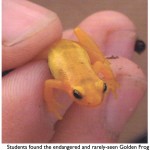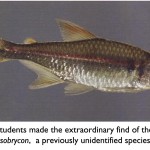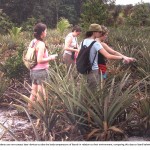Systematics and biogeography of fresh water fishes of Latin America; morphological evolution; conservation of aquatic ecosystems.
Links: Middletown Biodiversity Database
This database contains thousands of records of organisms identified here in Middletown by the 2007 BioBlitz [June 8 – 9] and by residents
The Tropical Ecology & the Environment [BIOL306] class went to Guyana on spring break in March 2006. The class was featured in Issue III [2006] of the Wesleyan magazine at http://www.wesleyan.edu/magazine. Below are pictures from this trip.
| Click on the thumbnails to view picture | ||
 |

rare golden frog |

Hyphessobrycon |

group picture |
 |

Ian McLeod ’07 |
|
|
||
| Four Studies, Four Ecosystems
While in Guyana, the students split into four groups to undertake specific field studies. Each group had to write a paper based on their study and present their findings to faculty, administrators, and other students. Links to the below papers are in the article Rainforest Classroom by David Pesci at http://www.wesleyan.edu/magazine. |
||
| COMMUNITY ECOLOGY OF STREAM FISHES IN GUYANA: The group sought to learn whether they could discern statistical differences between fish assemblages in black-water and clear-water environments. They also wondered if assemblages in separate locations that were within close geographical proximity to each other would be similar. Surveys took place in the Potaro River, the Madewini River, and tributaries of the Berbice River | ||
| FOREST DIVERSITY EFFECT ON LEAF MORPHOLOGY AND PLANT DIVERSITY: The group examined the differing types and characteristics within four distinct types of forests using transects and examining leaf morphology. The four forest types examined were: a dry evergreen forest on white sands; an inundated forest on a flood plain; a savannah forest; and an upland cloud forest (more commonly known as a rain forest). | ||
| THERMAL ECOLOGY OF GUYANESE LIZARDS: Students examined whether ambient temperature, air and ground, as reflected in the body temperature of lizards, had an effect on behavior, and if so, whether these effects varied between lizard species. | ||
| INSECT ATTRACTION TO FROG VOCALIZATION: The group examined whether mosquitoes and blood-sucking flies that preyed upon frogs were attracted to the mating calls of these frogs. The study used insect traps placed in proximity to pre-recorded indigenous frog mating calls, as well as control traps without sounds. | ||
